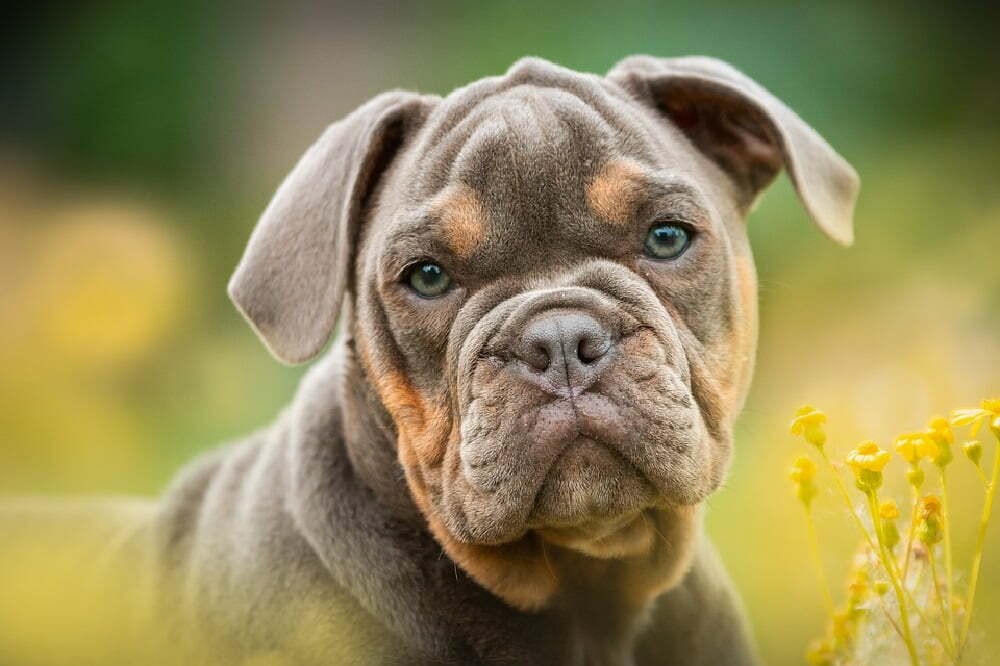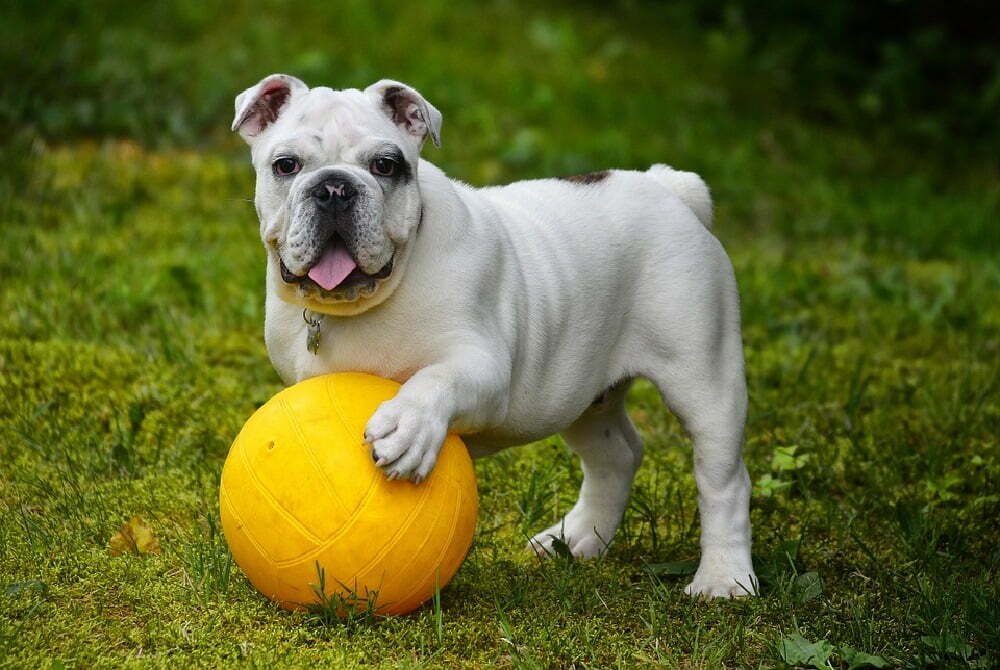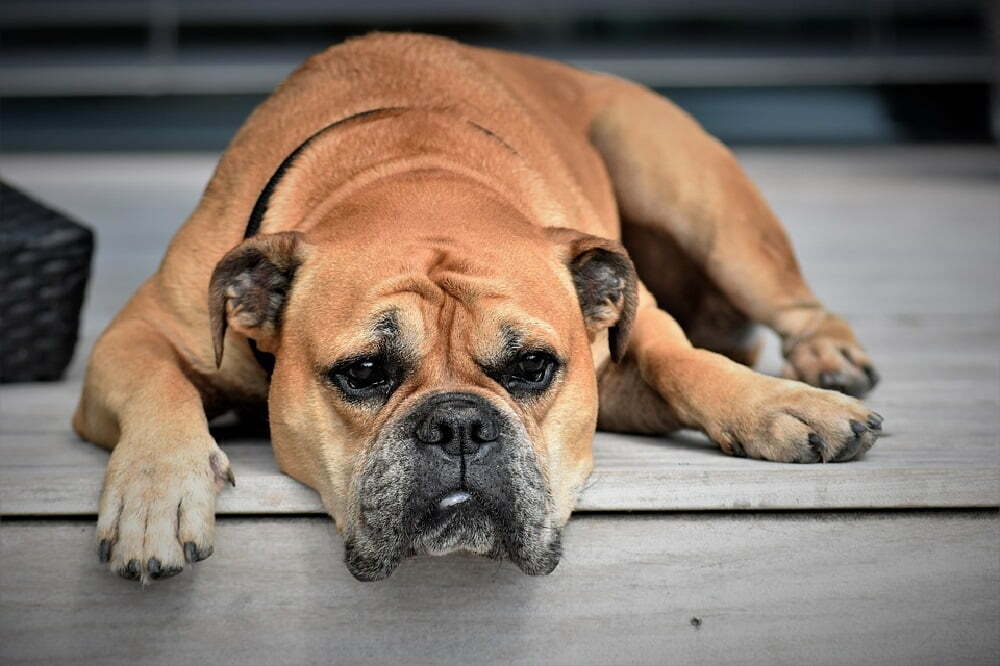Bulldogs (otherwise known as British bulldogs or English bulldogs) have an unmistakable look and personality. They’re big-boned, goofy, and completely lovable. The bulldog is also courageous and extremely gentle.
Originally bred to be fighting dogs, they have become a universal symbol of toughness and tenacity. But while you can find bulldogs on the emblems of many schools, businesses, and sports teams, you can most often find them chilling with their human families, watching the world go by from the comfort of their beds.

Below, we’ll tell you everything you need to know about the bulldog and why they are the fifth most popular dog breed in the U.S.
Key facts
Average lifespan: 8 years, but with a loving home, the right conditions, and good nutrition, they could live up to 10 years of age.
Minimum exercise (per day): While they enjoy a slow life of lounging on the couch or on your lap, they do need an hour of exercise per day.
Coat length: Bulldogs have a short coat that comes in a red, white, or fawn color. However, you can also find bulldogs with a rare coat of black, blue, or lilac.
Minimum cost (per month): Depending on what type of health insurance you choose, the minimum cost of a bulldog can vary. Price ranges for insurance usually start at around $60 per month and can rise to $130 per month.
Besides the initial cost of your bulldog pup, and ongoing veterinary and health insurance, we also need to factor in other costs such as dog food, medicines, grooming, and boarding/pet sitting.
Due to their squishy faces, bulldogs do have trouble breathing, and your vet may recommend a dry food that is easy for your bulldog to chew or maybe a wet food that is easy to chew and swallow. A 30-pound bag of high-quality dry food for British bulldogs can cost around $60.
Appearance
British bulldogs have an iconic appearance and are probably the first breed that comes to mind when you think of bulldogs.
They are sturdy dogs with short limbs and wide, stocky bodies. A staple trait of the bulldog is their huge underbite, sometimes referred to as ‘hanging a fang.’ They’re also known for their overhanging skin, wrinkled face, and their nose rope. They sit low to the ground and have wide shoulders, which is probably why they were considered such good fighting dogs. Their eyes are normally dark brown or black.
Size: Medium-sized. These dogs are considered relatively short. A British bulldog is roughly two times bigger than a cat.
Average height: A healthy female should be 30 cm tall, while a male should be 38cm tall.
Average weight: The average weight of a bulldog is 40-50 pounds.
Temperament
Despite their grumpy expressions and intimidating build, bulldogs are friendly and goofy, making them perfect for families with kids.
As with any dog, socialization is key, and when socialized early, they will develop a sweet, gentle temperament. But if not socialized, then they will become territorial (bulldogs are extremely loyal) and unmanageable around other dogs and animals. If they are not used to being around strangers, they can become quite defensive.
As puppies, bulldogs must be exposed to children, people, and animals in order to achieve that laid-back attitude they are known for. The more positive interactions they have with new people and surroundings, the better! They are rarely aggressive and, in fact, are quite dopey.
Apartment living: Their low energy level and enjoyment of the indoors means they can thrive in apartment settings. They don’t need a huge yard to run around and will tire of playing and will need a nap after about 10 minutes.
Good for novice owners: Their low-key, laid-back nature makes them ideal for first-time dog owners. They don’t require a whole lot of exercise and just love kicking back with their owners.
Sensitivity level: Although they are stubborn, British bulldogs are surprisingly sensitive. They respond well to patient, persistent training, and are able to remember what they have learned.
Tolerance for being alone: Bulldogs can cope with being alone, but only when they have been trained to do so. Bulldogs are great companion dogs and are at their happiest when near their owners. If left alone, they may experience separation anxiety and behave badly. Bulldogs can be left alone as long as they are potty and crate trained, are able to have regular, safe exercise by themselves, have an established eating schedule, know to chew only toys, and have been trained to overcome separation anxiety.
Tolerance for hot weather: Heat stress and heat stroke are extremely dangerous for bulldogs. Their very short muzzles mean they have trouble breathing, which means they have difficulty cooling themselves down in warm weather.
On hot days, keep your bulldog inside with the air-conditioning on to keep them cool, and make sure they have access to cool, fresh water at all times. If it’s particularly hot, you can even put a few ice cubes in their water to keep it cold.
Tolerance for cold weather: Bulldogs generally can’t tolerate extreme temperatures, and anything below freezing is too cold for them. Bulldogs can be out in above-freezing weather for up to 15 minutes on a short walk without experiencing harm. 60-70 degrees Fahrenheit is the ideal temperature for a bulldog.
Affectionate with family: Bulldogs are companionable dogs, and as they love to be indoors and part of the family, they make great family pets. Do not leave them unsupervised in a garden or yard that is visible to passersby, as they could be a target for dognapping.
Kid-friendly: Bulldogs love children, and their laid-back temperament means they can put up with all the noise, yanking, and tugging that comes with children’s natural curiosity about their furry friends! They will never show their anger, though. If they’re not feeling the attention, they will just walk away. However, young bulldogs are more prone to be excited, and their sheer weight will be enough to knock a toddler over easily. Of course, you should never leave dogs alone with children. Bulldogs are very protective of their family, though, and are generally very loving.
Dog-friendly: Most bulldogs will get on well with another pet or other animals. If you have another dog or a cat, you should introduce a young bulldog puppy to establish a hierarchy. Introducing an older bulldog or a dog of a similar age to your other dog or cat may cause problems.
Friendly towards strangers: Bulldogs are very amiable and are one of the most docile and mellow breeds. While they are easy-to-please dogs, they also have a stubborn streak. Most dogs will be fairly friendly towards strangers, although they may become a little bit more aggressive around strange dogs.
Health and Grooming

Shedding: Bulldogs have short, spiky hair that can shed and cling to clothes.
Drooling: Bulldogs are generally dry-mouthed except when they’ve had a drink. But they may also start to salivate while watching you and your family eat dinner!
Grooming: Bulldogs have short and very fine coats and only require brushing once a week. With regular brushing, you’re sure to find less and less hair on your furniture and clothes. However, keeping your bulldog’s face clean and dry is even more important.
This is because their wrinkly faces can get irritated or infected if not cared for properly. You should also trim their nails once a month so they’re not click-clacking on the floor. Also, weekly or daily teeth brushing will save on vet visits!
General health: Unfortunately, bulldogs are prone to health problems. Their short, bullish stature can lead to them having joint or respiratory difficulties. Adult bulldogs have a tougher time than other dogs regarding their health and are prone to osteoarthritis and degenerative joint disease. All bulldogs should have a cardiac exam, a patella evaluation, and an evaluation for tracheal hypoplasia.
Common health problems
Bulldogs may experience a few health problems over their lifetime and below are some of the most common health problems faced by the breed.
Brachycephalic Airway Syndrome (BAS): Brachycephalic is Latin for ‘smooshed face’ and is common in animals that have short facial features that push their noses in. Every British Bulldog suffers from BAS to some degree.
Brachycephalic dogs have the following conditions:
- Elongated soft palates – This is when the soft palate extends into the airway, making it harder for dogs to breathe and creating more resistance in the airway. When the pressure builds, it can lead to edema, or inflation of the palate, causing the airways to narrow.
- Stenotic Nares – This condition occurs when your dog has pinched or narrow nostrils. This makes it hard for them to inhale air. You can hear this condition in action when your bulldog snorts or snores. If it impacts your pup’s health, your vet may suggest surgery to widen the nostrils.
- Pneumonia – Pneumonia occurs when the lower respiratory tracts become irritated. This irritation usually happens when your dog inhales their vomit or regurgitation and can cause severe damage to the lungs and surrounding tissue.
Canine Hip Dysplasia: Dysplasia occurs when bones don’t fit into their joints, particularly in the hips. It’s painful, making your bulldog less likely to exercise, and can cause lameness and inability to get up. According to the Orthopedic Foundation for Animals, British bulldogs have the highest incidence of hip dysplasia of all dogs. 71% of British bulldogs are dysplastic.
Joint and ligament injuries: British bulldogs are more prone to joint and ligament injuries because of their build. If they are over-exercised or they get injured – especially as a puppy – it could lead to long-term issues like osteoarthritis. The best way to prevent this is to feed your dog a healthy diet and make sure they have a consistent exercise routine.
Arthritis: Much like in humans, canine arthritis occurs when cartilage in the joints wears down or becomes injured, and the bone is no longer protected. The exposed bones start to rub against each other and cause severe discomfort.
Potential for weight gain: While bulldogs aren’t the most active dogs, they still need to maintain a healthy weight. Especially as they are prone to weight gain, a daily walk around the neighborhood at a cool time of day will wear them out, as will a quick play session. They would much rather be cuddling with you or taking a nap. Ask your vet for food recommendations, and monitor how much food they’re eating to prevent weight gain. Bulldogs are better off with two measured meals a day rather than a bowl being left out all the time. They’ll just keep eating otherwise!
Trainability
Easy to train: Because they are naturally lazy dogs, bulldog owners need to be focused and patient with their puppies. Bulldogs respond well to positive encouragement and engagement when they’re feeling energized. Training should never be forced, repetitive, or heavy-handed, or they become too bullish. Keep training times short so you always have their full attention.
They will also retain information better in shorter training sessions. They are sure to remember once they’ve learned something, especially if they’re rewarded with a treat.
Intelligence: Bulldogs are famously stubborn and were ranked in the bottom ten of the ‘most intelligent dog breeds’ by Dr. Stanley Coren. They do find it hard to follow instructions and do not have the most intuitive problem-solving skills.
Potential to bite: All dogs will bite when they are young. Like human infants, they will go through a teething phase, during which time they will put anything and everything they can in their mouths – including fingers! Anybody who has petted a puppy on the head will have experienced this.
Bulldogs who are no longer puppies but continue to bite will not have learned that they shouldn’t bite humans, and without intervention, this will continue into adulthood and become dangerous. As an owner, it’s up to you to make sure your bulldog is trained not to bite people.
Tendency to bark or howl: Bulldogs very rarely bark or howl, but their intimidating build and unimpressed appearance makes them great watchdogs who can frighten any unwanted visitors off! They are also known for their courage and will do anything to protect their loved ones.
History

The bulldog as we know it today has evolved quite a bit from its ancestors. In 13th century England, bulldogs were used for the brutal sport of bull-baiting. Before professional sports were established, spectators would gather and bet money on this inhumane practice. One or multiple bulldogs would attempt to pin a bull to the ground with their powerful bite.
These early bulldogs were a bit taller and more muscular than the modern British bulldog, and only the most aggressive were bred. It is believed this is where the bulldog acquired its famous tenacity because they developed a high tolerance for pain and wouldn’t stop fighting until the end.
Bull-baiting was finally outlawed in England in 1835, and without the practice, bulldogs were facing extinction. But many people admired their strength, determination, and appearance and didn’t let them die out. Breeders dedicated their lives to re-engineering the bulldog. They bred only the even-tempered dogs until only the docile dogs were left. The British bulldog was recognized by the American Kennel Club in 1886.
The British bulldog is synonymous with their country of origin and a symbol for the British people. The dog is closely associated with Prime Minister Winston Churchill and personified the leader who is often credited as firmly leading Britain during World War II with a bulldog-like tenacity. Plus, he kind of looked like a bulldog too!
Now the bulldog is known to be one of the most gentle dogs around and a perfect dog for families with children.
Costs
A British bulldog puppy is likely to cost between $1,500 – $4,500. The average price is $2,500. First-year expenses can be around $5,000 and will probably be about $1,400 a year (or $114 a month) after that.
Through a bulldog’s lifetime, the average cost of owning one will be about $16,100.
Additional costs such as spaying or neutering your British bulldog, sending them to a boarding facility one week every year, or hiring a dog walker every day could raise the cost to about $47,000 to $93,000. This scenario would put the overall average cost of caring for a British bulldog at $68,200 throughout its lifetime.
Fun Facts
- British bulldogs are mascots for many schools, businesses, and organizations, including the United States Marine Corps. You can find a bulldog mascot in many U.S. bases.
- Also, around 40 universities in America have British bulldogs as their official mascot.
- Bulldogs are also apparently a president’s pet of choice. President Calvin Coolidge owned a bulldog named Boston Beans, who lived in the White House with the family and their other pets, while President Warren G. Harding also had a pet bulldog in the White House called Old Boy.
- A bulldog from Lima, Peru, named Otto, set a world record in 2015 for “the longest human tunnel traveled through by a dog skateboarder.”
